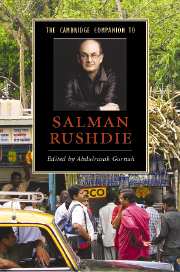Book contents
- Frontmatter
- 1 Introduction
- Part I: Themes and Issues
- Part II: Studies of Individual Texts
- 6 Tricksters and the common herd in Salman Rushdie’s Grimus
- 7 Themes and structures in Midnight’s Children
- 8 Reading ‘Pakistan’ in Salman Rushdie’s Shame
- 9 The Satanic Verses: ‘To be born again, first you have to die’
- 10 The shorter fiction
- 11 The politics of the palimpsest in The Moor’s Last Sigh
- 12 The Ground Beneath Her Feet and Fury: The reinvention of location
- Guide to further reading
- Index
- Series List
6 - Tricksters and the common herd in Salman Rushdie’s Grimus
from Part II: - Studies of Individual Texts
Published online by Cambridge University Press: 28 November 2007
- Frontmatter
- 1 Introduction
- Part I: Themes and Issues
- Part II: Studies of Individual Texts
- 6 Tricksters and the common herd in Salman Rushdie’s Grimus
- 7 Themes and structures in Midnight’s Children
- 8 Reading ‘Pakistan’ in Salman Rushdie’s Shame
- 9 The Satanic Verses: ‘To be born again, first you have to die’
- 10 The shorter fiction
- 11 The politics of the palimpsest in The Moor’s Last Sigh
- 12 The Ground Beneath Her Feet and Fury: The reinvention of location
- Guide to further reading
- Index
- Series List
Summary
Flapping Eagle, the Amerindian protagonist of Salman Rushdie's Grimus (1975), has many of the characteristics of the prototypical Native American trickster. He is both 'a creator of order out of chaos and a destroyer of order which represses creative energies, [as] an animal being and a spiritual force', and '[w]hatever else he may be, [he] is also a SURVIVOR who uses his wits and instincts to adapt to changing times'. In her anthropological study In Favor of Deceit (1987), Ellen B. Basso points out that '[t]he widespread occurrence of trickster characters in folklore has long been an intriguing puzzle to anthropologists and folklorists, who have written insightfully - but exceedingly sporadically - about these mythological figures'. Franz Boas was, for instance, impressed by 'the “troublesome psychological discrepancy” between the apparently incongruous attributes of the “culture hero” (who makes the world safe and secure for human life) and the “selfish buffoon” (who ludicrously attempts the inappropriate)'. Others have emphasised the trickster's explicit status as an outsider - 'strikingly antisocial, marginal, or ambiguous' - and that he represents, in Karl Kerényi's words, the 'spirit of disorder, [as] the enemy of boundaries'.
- Type
- Chapter
- Information
- The Cambridge Companion to Salman Rushdie , pp. 77 - 90Publisher: Cambridge University PressPrint publication year: 2007

